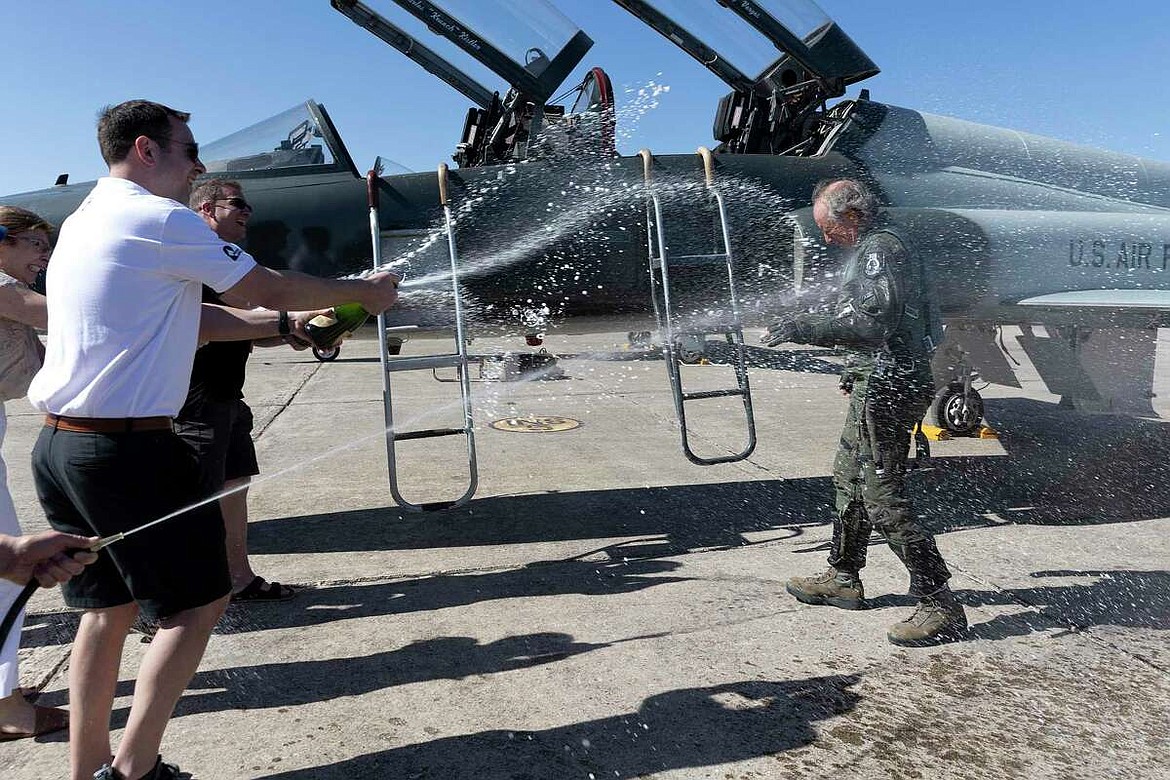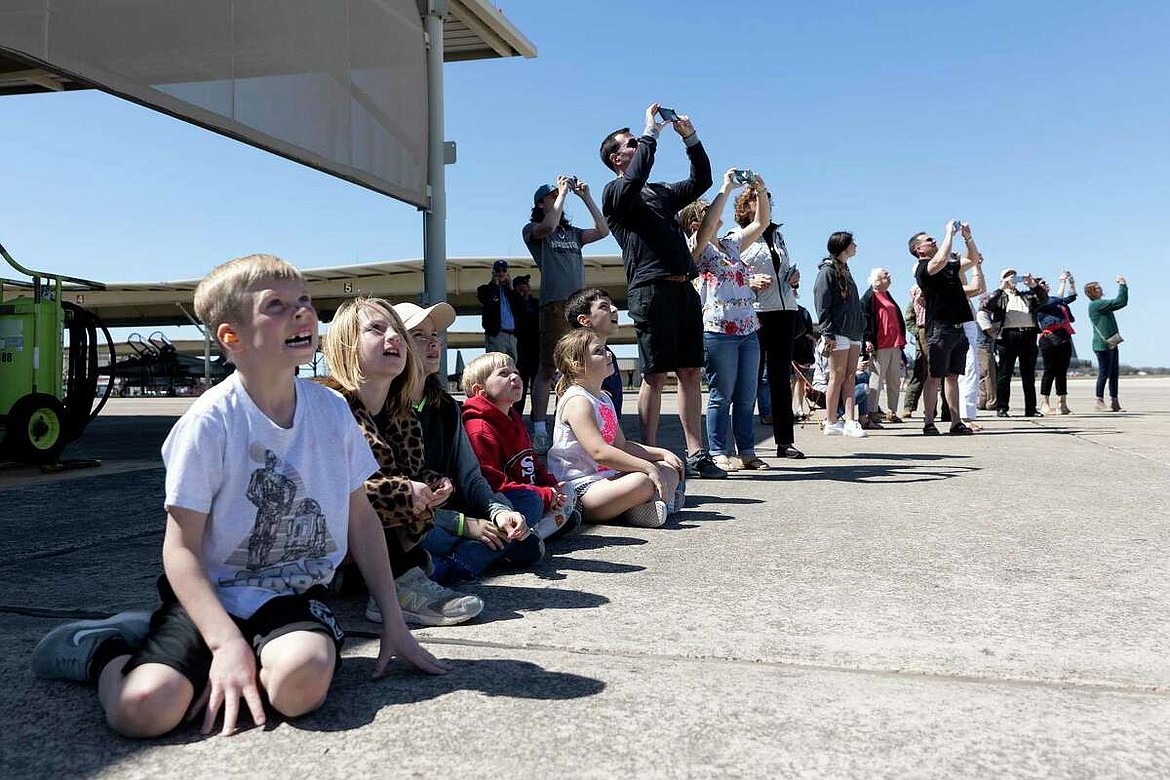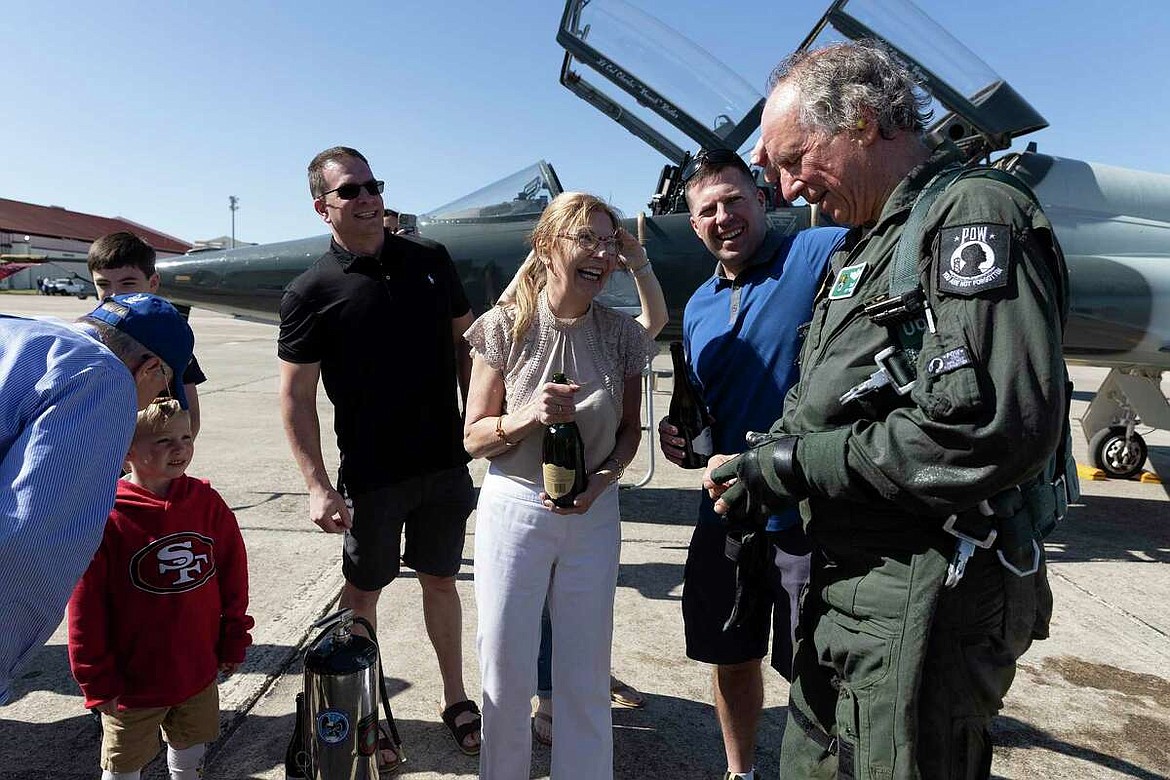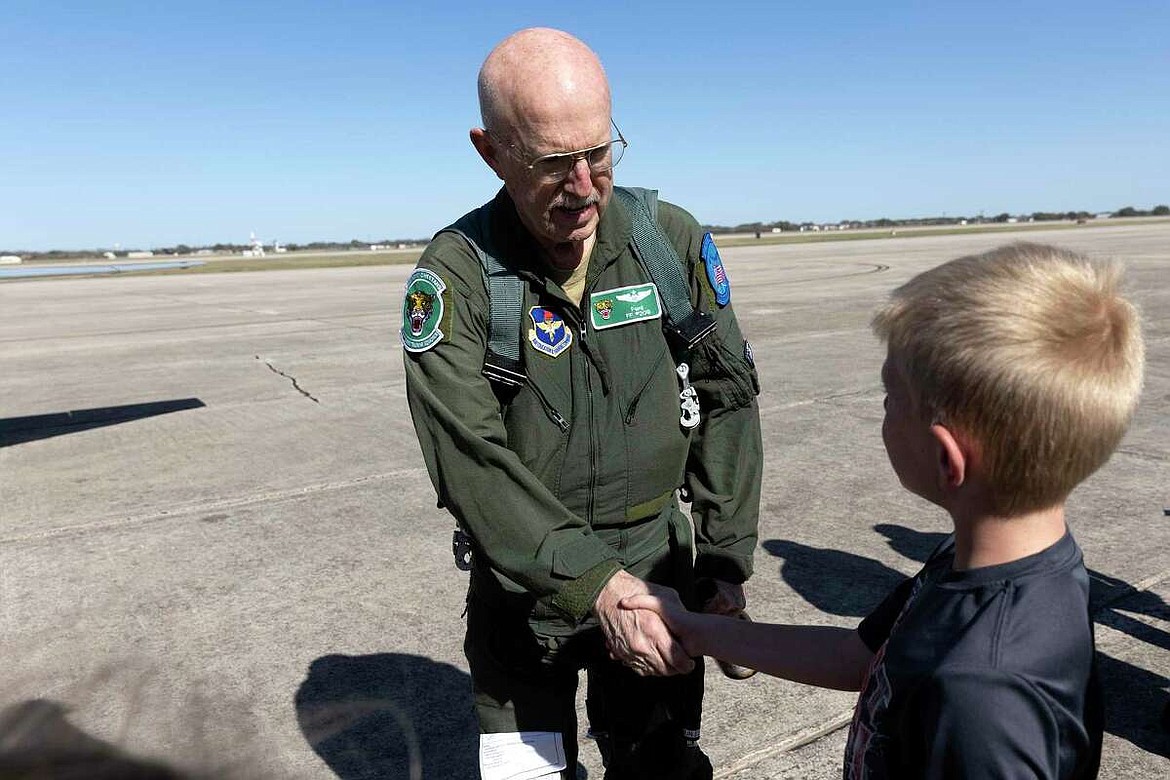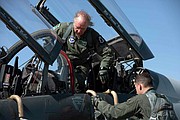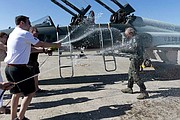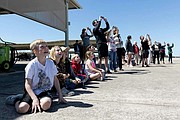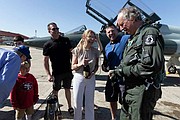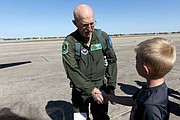Two who came home: Former Vietnam POWs go for a ride at Randolph
SAN ANTONIO — The food at the Hanoi Hilton was worse than just bad. As a prisoner of war, Ted Sienicki found the bread full of insects.
Many of the POWs ate the rations anyway — with predictable results. One prisoner removed something from his body — just what isn’t clear — that was 19 inches long.
“It looked like a long worm of some type,” said Sienicki, a retired Air Force major who, in 1973, had returned home from 330 days of captivity 40 pounds lighter and sickened by five different parasites. “We’re eating filthy food, we had bread instead of rice (that) was full of cockroach wings and legs and stuff like that, so there was plenty of opportunity to have germs there.
“The guy I got shot down with tried to pick out the cockroach parts out of his bread and spent hours doing it,” Sienicki said. “There were contests in the camp of who could pull the longest live animal out of their body, any orifice. This game started because people used to have worms crawling out of their nose or mouth at night. And the winner was in the room next to me.”
The 19-inch worm isn’t even his worst story, and the tales are enough to make people wonder how 684 of the Americans who were captured, held and sometimes tortured in North Vietnamese prisons over the long war made it home alive.
In all, 113 did not.
Both among the lucky ones, Sienicki and retired Air Force Lt. Col. Frederick McMurray of Coeur d'Alene had reason to celebrate Thursday as they were given final “Champagne flights” in supersonic T-38C jets at Joint Base San Antonio-Randolph.
Sienicki, who had learned to fly at Randolph, also marked his 74th birthday.
Dozens of family members, friends and well-wishers, many of them pilots with the 560th Flying Training Squadron, welcomed the former POWs with cheers, applause and the traditional spraying of a bottle of bubbly, which soaked the men in their olive green flight suits on a cool, sunny afternoon.
The 50-minute flight was “absolutely wonderful,” said McMurray, 76.
Maj. Ryan “Popeye” Parrish, 35, said it was an honor to fly with him.
“The tribulations one goes through for any time in captivity, it’s just remarkable, a testament to the fortitude that him and all the other former POWs have,” he added. “They were able to hold their heads up high.”
Recounting in earlier interviews how they jumped from crippled jets, desperately tried to evade capture and stayed determined to survive grim and brutal captivity, both McMurray and Sienicki, of Roanoke, Va., were able to inject occasional humor in their stories.
In solitary confinement for two months in a section of the Hanoi prison called “Heartbreak Hotel,” McMurray found no one to talk to from his 7-by-7-foot cell. And as time passed, he sank deeper into depression.
“If you worry all day long, really concerned, upset all day long, that’s not good. And as the days progressed, I worried — all simultaneous — I worried about my wife, and my three children and my mom and my dad and her mom and her dad,” he said. “I worried about my health. I worried about my back. I worried about how long I was gonna be there.
“I knew one prisoner had been there damned near nine years,” McMurray said.
Sienicki, a native of Elizabeth, N.J., lived in a room at the Hanoi Hilton with more than 40 other POWs and said the 19th century, French-built penitentiary looked a lot like the one in the movie, “Papillon,” set on Devil’s Island in French Guiana.
Hóa Ló prison, its real name, was grittier than the one in the movie. Sienicki recalls rats that were more than a match for the rat terriers that patrolled the prison, often engaging them in loud, screaming fights at night.
Once or twice a year, the Vietnamese would chemically sanitize a pair of holes in a room that were used as latrines, triggering a roach infestation straight out of a Stephen King movie.
“They would be 3 feet thick on all the walls until they got shoveled away. But they were dazed by the chemical. They came up (the hole) and they just started climbing up the walls, and the next ones climbed over them and over them and over them and over them.”
Sometimes a Vietnamese guard would kill a pig, cook it and discard parts that contained hair, skin and a layer of fat. There might be a sliver of meat in the fat, which had been cut into chunks and handed to the prisoners.
Sienicki said a lot of the POWs couldn’t eat it. Some would.
“This guy sent a message over,” he recalled. “He said, ‘Do you have any pig fat left over?’ And the answer was, ‘Yes, but it’s kind of rancid because it’s 100 degrees and it’s been sitting around all day.’ And he came back and he said, ‘Send it over.’”
One last mission
McMurray and Sienicki, both captains at the time they were taken prisoner, were weapons officers aboard F-4 Phantom fighter-bombers based at Ubon Royal Thai AFB in Thailand. They later became pilots and flew the F-111 before retiring, but they were relative newcomers to the Air Force when they made their last combat missions. McMurray earned his navigator’s wings in May 1969, Sienicki in April 1971.
McMurray and his wife, Judy, were thinking of his return home when he awoke Sept. 12, 1972. He’d been told there would be no more missions over North Vietnam and that he’d return to his base in North Carolina in a couple of weeks. But his flight commander, Capt. Rudy Zuberbuhler, said he’d lost his backseater and needed McMurray to fill in.
“It was supposed to be a simple mission,” McMurray said. “That’s what he said.”
But the target was a railroad northeast of Hanoi. Combat sorties over North Vietnam were never simple or low risk. The enemy contested the air space with sophisticated anti-aircraft weaponry and fighters that included the MiG-21, a nimble Soviet-made jet that some experts have argued was the best of the war.
It was Sept. 11 on the other side of the international date line, his seventh wedding anniversary. Judy celebrated it with his parents in Coeur d’Alene, Idaho. The next day, she and the kids flew to Raleigh-Durham, N.C., expecting him home in weeks.
Zuberbuhler and McMurray were among eight F-4s laying down a “chaff corridor” that, like a smoke screen, was designed to prevent the North Vietnamese radar systems from seeing others that would come in behind them to bomb the target.
McMurray spotted a pair of MiGs and yelled, “Bandits three o’clock! Break right! Break right!”
The enemy planes closed as Zuberbuhler maneuvered.
“They couldn’t get (in position) for a shot,and I thought if we rolled over, that if we reverse, maybe we’d be able to get a shot at them, so I said, ‘Zub, reverse for a shot! Reverse for a shot!’
“And he did, but as we came back around I was looking at them and they were disengaging, so we needed to roll out. We can’t go after them, we have to get this (chaff) corridor going. Zub rolled out and we immediately got hit.”
Damaged by a heat-seeking missile fired from one of the MiGs, they tried to get their F-4 to Haiphong Harbor and the Gulf of Tonkin, 14 miles away, where a U.S. ship might rescue them. But one engine was on fire, part of a wing was gone and the blaze destroyed the hydraulic system, pitching the plane violently, straight up. The men ejected.
Flying with Capt. Tim Ayers, Sienicki’s 53rd mission May 3, 1972, was over the Demilitarized Zone separating North and South Vietnam. His commanders wanted to assess damage from a bombing mission over an area that now included paved roads for troop movement into the south and seven surface-to-air missile sites.
“We got hit just behind the cockpit. The airplane fell into two pieces,” Sienicki said. “We were in the front piece tumbling end over end, the part with no wing. We ejected low to the ground, I had one swing in the chute.
“There were an untold number of people all firing at me from four directions.”
The downed Americans managed to evade hundreds of Vietnamese on the ground, using tricks they’d learned from survival training. Sienicki hid in a bush and might have eluded his pursuers if one of them hadn’t stepped on him. Soon he was surrounded and beaten by a mob that tried to remove his boots. They ran into a problem.
“No one knew how to work a zipper,” Sienicki said.
Organizing, mentally
McMurray managed to remain free overnight after landing in the jungle. Local militia captured him the next afternoon and he soon met North Vietnamese regulars who gave him the treatment Sienicki received — a beating that included being hit in the back, which had been fractured, as well as a broken nose and tooth. He was thrown to the floor of a van and kicked en route to Hanoi.
In prison, Sienicki became a con artist, trying to convince his captors that he was stupid and that interrogating him was a waste of time. McMurray was never physically tortured over his 199 days of captivity, but was in true peril while in solitary.
His racing thoughts were all-consuming.
“I thought about Judy continually. And somehow I knew I had to … get in control of myself, so I ended up limiting when I could think of different things, and so I set aside that. I would think of Judy right after dinner. I would think of my kids in the afternoon. I would think of my parents a little later,” he said.
“So I got myself organized and I started exercising. I set up a time of the day to do that. I ended up having a private little Mass — I’m Catholic — on Sundays, and said as many prayers as I could think of, and so when I found myself doing that, not only was I not worrying but then I found myself looking forward to things.
“If you are in a difficult situation and you can look forward to something, I say, ‘My God, it’s about four hours and I’ll get to think about Judy! Won’t that be fun!’”
At Randolph on Thursday, the Champagne flights were followed by food, drinks, a festive atmosphere and a sense of awe surrounding the former prisoners. On Friday, the training squadron continued its salute to U.S. prisoners of war with a ceremony and a flyover of a B-1 bomber.
“I’m blown away by them, the legacy that they leave us,” said Lt. Col. Benjamin “Deacon” Williams, the 560th’s commander. “It’s easy to look back on the Vietnam War and know when it started and when it ended. That’s me looking back.
“For them, living through it as they were POWs, they didn’t have the luxury of knowing if was going to be only one year. To them it could have been another year, it could have been four years, 10 years,” he continued. “And yet they had the devotion to their duty, the devotion to their country to keep faith with the United States, that we were going to go in there and bring them home.”



